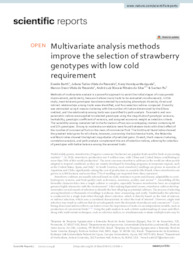Multivariate analysis methods improve the selection of strawberry genotypes with low cold requirement.
Multivariate analysis methods improve the selection of strawberry genotypes with low cold requirement.
Author(s): BARTH, E.; RESENDE, J. T. V. de; MARIGUELE, K. H.; RESENDE, M. D. V. de; SILVA, A. L. B. R. da; RU, S.
Summary: Methods of multivariate analysis is a powerful approach to assist the initial stages of crops genetic improvement, particularly, because it allows many traits to be evaluated simultaneously. In this study, heat-tolerant genotypes have been selected by analyzing phenotypic diversity, direct and indirect relationships among traits were identified, and four selection indices compared. Diversity was estimated using K-means clustering with the number of clusters determined by the Elbow method, and the relationship among traits was quantified by path analysis. Parametric and non-parametric indices were applied to selected genotypes using the magnitude of genotypic variance, heritability, genotypic coefficient of variance, and assigned economic weight as selection criteria. The variability among materials led to the formation of two non-overlapping clusters containing 40 and 154 genotypes. Strong to moderate correlations were found between traits with direct effect of the number of commercial fruit on the mass of commercial fruit. The Smith and Hazel index showed the greatest total gains for all criteria; however, concerning the biochemical traits, the Mulamba and Mock index showed the highest magnitudes of predicted gains. Overall, the K-means clustering, correlation analysis, and path analysis complement the use of selection indices, allowing for selection of genotypes with better balance among the assessed traits.
Publication year: 2022
Types of publication: Journal article
Unit: Embrapa Coffee
Keywords: Genotype, Multivariate analysis, Plant selection guides, Strawberries
Observation
Some of Embrapa's publications are published as ePub files. To read them, use or download one of the following free software options to your computer or mobile device. Android: Google Play Books; IOS: iBooks; Windows and Linux: Calibre.
Access other publications
Access the Agricultural Research Database (BDPA) to consult Embrapa's full library collection and records.
Visit Embrapa Bookstore to purchase books and other publications sold by Embrapa.

